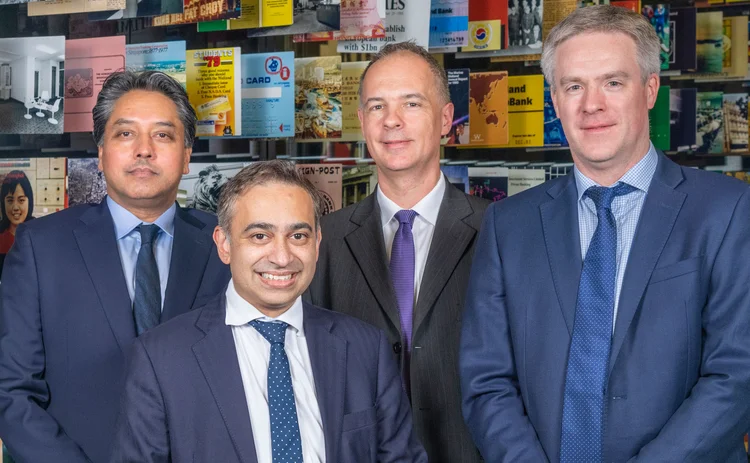
Bank risk manager of the year: HSBC
Risk Awards 2020: New market risk system proves its worth in a year of emerging market blow-ups

HSBC has seen more than its fair share of risk management challenges in 2019. Its home jurisdiction is mired in political inertia and uncertainty. Its other home market is erupting in flames. Add in a slew of emerging markets blow-ups, an ongoing trade war between the US and China, and a looming re-structuring, and the bank has needed all its wits just to hold things steady.
The one constant has been the ability of its traded risk team, which is responsible for managing market and counterparty credit risk, to protect the bank’s traders and keep it open for business when clients needed it.
Its management of this year’s renminbi volatility was a case in point. On August 1, after the US slapped tariffs on some $300 million worth of imports, China responded by allowing the yuan to weaken by 3.25% over the space of three trading days. The move sent the currency crashing through the psychologically significant threshold of 7 yuan to the dollar, its weakest level since the crisis.
HSBC was prepared. Every day, the bank runs foreign exchange spot ladders that anticipate moves in the yuan and its offshore variant and show what the impact would be if the currency appreciates or depreciates.
So far, so normal – but the bank’s role as a major counterparty to corporates hedging renminbi exposures makes this analysis critical. It also gives its traded risk team an added advantage. When it executes large trades early during Hong Kong hours, the team works with its traders to produce intraday versions of its ladders, giving its counterparts in Europe greater visibility into flows at the start of the London trading day, and a vital insight into which way the weight of positioning might drag the currency.
“The renminbi is a key currency for us, given the bank’s ties with China and Hong Kong. We are a key market-maker. We always focus on the risk, but we have to be there for our customers. We are prepared. We can estimate quickly what might happen in terms of immediate P&L impact should there be a large market move,” says Francois-Xavier Faure, the bank’s global head of traded risk for forex and commodities.
The bank manages the structural axes from this business carefully. A network of hedge fund clients and institutional investors help it recycle the long forex volatility positions it acquires from its structured forex forward sales to China corporates, flattening its market risk profile and allowing it to remain open for business when times are volatile.
Ahead of the renminbi’s slide, the bank had also been making use of scenario generation techniques to assess its exposure should the yuan suddenly weaken, says Faisal Yousaf, the bank’s global head of traded risk.
“We look at the impact of spot shifts, and we use stress testing as an active risk management tool to look at what could happen to the market under any kind of event; then we create playbooks to say ‘well, how would we respond?’ So for events like the shift in the rmb, we’re able to put those playbooks into action quite quickly. Ultimately, the spot shift was pretty manageable – but if it had been more significant, we felt well placed to respond,” says Yousaf.
Currency volatility was not unique to China. That same month, a strong showing in primary elections for the left-wing opposition Peronist party sent Argentina’s currency sliding by more than a fifth to 60 pesos against the dollar. The country’s embattled president, Mauricio Macri, announced plans for an emergency debt restructuring. Credit default swap (CDS) spreads still blew out by more than 2,000 basis points in the days that followed, with markets pricing in a more than 50% chance of a sovereign default within 12 months.
We can estimate quickly what might happen in terms of immediate P&L impact should there be a large market move
Francois-Xavier Faure, HSBC
It was against this backdrop that the bank began road-testing its new secret weapon: Laser. The market risk platform, which it is in the process of rolling out globally, uses data derived from HSBC’s vast trading operations to build an event-driven calendar for each country it does business in – elections, central bank dates and the like. This is combined with a corresponding map of its forward-looking exposures, right down to the instrument level, allowing risk managers to assess based on past observations whether any significant shifts in local market dynamics around those dates might cause its holdings to become illiquid.
As the dynamics of local market volatility shift, the bank is able to reassess its portfolio quickly, drilling down to names specific to that country or impacted sectors globally. It can then run other measures such as recovery ladders to determine the impact of a default.
“One of the things Laser does is give the senior management within traded risk a forward looking exposure of how our positions are building – not just in our traditional trading book portfolio, but also in other business growth areas like financing. We can see holistically how the portfolio in specific countries or with specific names is building up, and assess whether we should be concerned about any concentrations,” says Yousaf.

In a year when many banks suffered material losses on the Turkish lira and Argentinian peso, and bond holdings linked to those currencies, the bank’s performance was in line with its risk appetite and expectations at the start of the year.
One area HSBC kept a close eye on was the basis between Argentina’s bonds and sovereign CDSs. Ajay Yadav, global head of fixed income traded risk, says there is often a lag in moves in one filtering through into the other, making holding positions that play off the difference between the two hazardous.
“We try to keep that very visible,” says Yadav. “There are a lot of scenarios we run around it: we tend to model the curve into very different shapes, look at steepeners and flatteners, whether the basis is widening gradually – or not. You have to try and work out where you can be impacted on these basis positions. A lot of the scenarios we run are aimed at making sure we don’t get too large in any one pocket.”
Thanks to Laser, that didn’t happen. The bank’s risk managers were in constant communication with its traders in London and Buenos Aires and, where they no longer felt comfortable with the risk, instructed them to take remedial action, hedging or curbing positions where needed.
A lot of the scenarios we run are aimed at making sure we don’t get too large in any one pocket
Ajay Yadav, HSBC
Emerging markets traders have always sought to claim the upper hand in disputes with their desk’s risk manager when it comes to local knowledge, arguing this gives them the ability to trade out of positions when things turn sour. But the bank’s analysis of trading data is fast superseding this knowledge: only available to risk managers so far, HSBC plans to make the system available to all traders globally, too, democratising its insights and speeding up conversations around positions and exposure.

“Because you have real-time access to this information, it’s not the case that you have to sit down, as you might have done a few years ago with the trader and look at various scenarios, look at what happened – then go away and spend a couple of hours pulling that data, running those scenarios. You can sit down in a meeting room at a desk and analyse these positions as necessary. That’s a change in ways of working,” says Yadav. “It’s not necessarily that we make decisions differently, we’re just able to make them quicker.”
Only users who have a paid subscription or are part of a corporate subscription are able to print or copy content.
To access these options, along with all other subscription benefits, please contact info@risk.net or view our subscription options here: http://subscriptions.risk.net/subscribe
You are currently unable to print this content. Please contact info@risk.net to find out more.
You are currently unable to copy this content. Please contact info@risk.net to find out more.
Copyright Infopro Digital Limited. All rights reserved.
You may share this content using our article tools. Printing this content is for the sole use of the Authorised User (named subscriber), as outlined in our terms and conditions - https://www.infopro-insight.com/terms-conditions/insight-subscriptions/
If you would like to purchase additional rights please email info@risk.net
Copyright Infopro Digital Limited. All rights reserved.
You may share this content using our article tools. Copying this content is for the sole use of the Authorised User (named subscriber), as outlined in our terms and conditions - https://www.infopro-insight.com/terms-conditions/insight-subscriptions/
If you would like to purchase additional rights please email info@risk.net
More on Awards
Joining the dots: banks leverage tech advancements for the future of regulatory reporting
The continued evolution of regulatory frameworks is creating mounting challenges for capital markets firms in achieving comprehensive and cost-effectiveawa compliance reporting. Regnology discusses how firms are starting to use a synthesis of emerging…
Markets Technology Awards 2024 winners' review
Vendors spy opportunity in demystifying and democratising – opening up markets and methods to new users
Derivatives house of the year: JP Morgan
Risk Awards 2024: Response to regional banking crisis went far beyond First Republic
Risk Awards 2024: The winners
JP Morgan wins derivatives house, lifetime award for El Karoui, Barclays wins rates
Best product for capital markets: Murex
Asia Risk Awards 2023
Technology vendor of the year: Murex
Asia Risk Awards 2023
Best structured products support system: Murex
Asia Risk Awards 2023
Energy Risk Asia Awards 2023: the winners
Winning firms demonstrate resiliency and robust risk management amid testing times
Most read
- Top 10 operational risks for 2024
- Top 10 op risks: third parties stoke cyber risk
- Japanese megabanks shun internal models as FRTB bites







